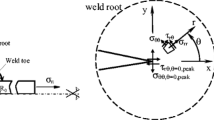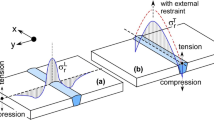Abstract
At welded joints, fatigue cracks usually initiate either at the weld toe or the weld root. The latter may be influenced by small defects or other irregularities or even by non-fused root faces forming a slit which acts like a crack. Weld root failure has therefore to be checked for several weld types. Different approaches exist for fatigue assessment, including the rather simple nominal stress approach, local stress approaches and the crack propagation approach which are partly well suited for the assessment of weld root fatigue. However, it is not easy to keep the overview and to decide which approach should be applied in the case in question. For this purpose, the guideline has been established giving an overview of the different approaches with special emphasis on weld roots and discussing their suitability and the limitations. Six typical examples are described where different approaches are applied and in some cases compared with fatigue tests, thus giving insight into the practical application and allowing own judgement.






























































Similar content being viewed by others
References
Andrews R M (1988) The effect of misalignment on the fatigue strength of welded cruciform joints. IIW-Doc. XIII-1180-85
Anderson TL (1995) Fracture mechanics: fundamentals and applications, 2nd edn. CRC Press, Boca Raton
Barsoum Z, Barsoum I (2009) Residual stress effects on fatigue life of welded structures using LEFM. Eng Fail Anal 16:449–467
Barsoum Z (2008) Residual stress analysis and fatigue of multi-pass welded tubular structures. Eng Fail Anal 15:863–874
Boukharouba T, Tamine T, Nui L, Chehimi C, Pluvinage G (1995) The use of notch stress intensity factor as a fatigue crack initiation parameter. Engng Fract Mech 52:503–512
BS 7608 (1993) Code of practice for fatigue assessment of steel structures. British Standards Institution, London
Carpinteri A (ed) (1994) Handbook of fatigue crack propagation in metallic structures. Elsevier, Amsterdam
DNV (2010) Fatigue strength analysis of offshore steel structures. Report DNV-RP-C203, Det Norske Veritas, Høvik
Fischer C, Feltz O, Fricke W, Lazzarin P (2011) Application of the notch stress intensity and crack propagation approaches to weld toe and root fatigue. Weld World 50(7/8):30–39
Frank D, Remes H, Romanoff J (2011) Fatigue assessment of laser stake-welded joints. Int J Fatigue 33:102–114
Fricke W (2005) Effects of residual stresses on the fatigue behaviour of welded steel structures. Mat-wiss u Werkstofftech 36:642–649
Fricke W (2012) IIW recommendations for the fatigue assessment of welded structures by notch stress analysis. Woodhead Publishing, Cambridge
Fricke W, Doerk O (2006) Simplified approach to fatigue strength assessment of fillet-welded attachment ends. Int J Fatigue 28:141–150
Fricke W and Kahl A (2006). Fatigue assessment of weld root failure of hollow section joints by structural and notch stress approaches. In: Proc of In. Symp on Tubular Structures (ISTS'11), Quebec
Fricke W, Kahl A and Paetzold H (2006) Fatigue assessment of root cracking of fillet welds subject to throat bending using the structural stress approach. Weld World 50(7/8):64–74
Hobbacher A (2009) Recommendations for Fatigue Design of Welded Joints and Components. IIW doc.1823-07, Welding Research Council Bulletin 520, New York
Hong J K (2010): Evaluation of weld root failure using Batelle structural stress method. In: Proc. 29th Int Conf on Ocean, Offshore & Arctic Engng (OMAE2010). ASME, New York
Lazzarin P, Tovo R (1998) A notch intensity factor approach to the stress intensity of welds. Fatig Fract Eng Mater Struct 21:1089–1103
Lazzarin P, Zambardi R (2001) A finite-volume-energy-based approach to predict the static and fatigue behaviour of components with sharp V-shaped notches. Int J Fracture 112:275–298
Lazzarin P, Berto F, Gomez FJ, Zappalorto M (2008) Some advantages derived from the use of the strain energy density over a control volume in fatigue strength assessments of welded joints. Int J Fatigue 30:1345–1357
Lazzarin P, Meneghetti G, Berto F and Zappalorto M (2009) Practical application of the N-SIF approach in fatigue strength assessment of welded joints. Weld World 53(3/4):R76–R89
Livieri P, Lazzarin P (2005) Fatigue strength of steel and aluminium welded joints based on generalized stress intensity factors and local strain energy values. Int J Fract 133:247–278
Lotsberg I (2003) Fatigue capacity of fillet welded connections subjected to axial and shear loading. IIW-Doc. XIII-2000-03/XV-1146-03
Maddox S.J (1974) Assessing the significance of flaws in welds subject to fatigue. Welding J., Res. Suppl. 53:9, pp. 401s–409s
Maddox S J and Razmjoo G R (1998): Fatigue Performance of Large Girth Welded Steel Tubes. In: Proc. 17th Int. Conf. Offshore Mechanics and Arctic Engng. (OMAE'98). ASME, New York
Maddox S J, Doré M J and Smith S D (2010) Investigation of ultrasonic peening for upgrading a welded steel structure. IIW-Doc. XIII-2326-10
Meneghetti G, Lazzarin P (2006) Significance of the elastic peak stress evaluated by FE analyses at the point of singularity of sharp V-notched components. Fatig Fract Eng Mater Struct 30:95–106
Meneghetti G (2008) The peak stress method applied to fatigue assessments of steel and aluminium fillet welded joints subjected to mode-I loading. Fatig Fract Eng Mater Struct 31(5):346–369
Meneghetti G and Lazzarin P (2011) The peak stress method for fatigue strength assessments of welded joints with weld toe and weld root failures. Weld World 55(7/8):22–29
Niemi E, Fricke W, Maddox SJ (2006) Fatigue analysis of welded components—designer's guide to the hot-spot stress approach. Woodhead Publishing, Cambridge
Radaj D, Sonsino C M and Fricke W (2006) Fatigue assessment of welded joints by local approaches, 2nd edn. Woodhead Publishing, Abington
Radaj D, Lazzarin P, Berto F (2009) Fatigue assessment of welded joints under slit-parallel loading based on strain energy density or notch rounding. Int J Fatigue 31:1490–1504
Schijve J (2001) Fatigue of structures and materials. Kluwer Academic, Dordrecht
Sonsino CM (2009) Effect of residual stresses on the fatigue behaviour of welded joints depending on loading conditions and weld geometry. Int J Fatigue 31(1):88–101
Sonsino C M (2009b) A consideration of allowable equivalent stresses for fatigue design of welded joints according to the notch stress concept with reference radii r ref=1.00 and 0.05 mm. Welding in the World 53(3/4):R64–R75
Sonsino CM (2009) Multiaxial fatigue assessment of welded joints—recommendations for design codes. Int J Fatigue 31:173–187
Sonsino, C M (2011) Reliability aspects in fatigue design of welded structures using selected local approaches: the example of K-nodes for offshore constructions. In: K A McDonald (ed) Fracture and fatigue of welded joints and structures. Woodhead Publishing, Cambridge, pp. 239–275.
Sonsino CM, Bruder T, Baumgartner J (2010) S–N lines for welded thin joints—suggested slopes and FAT values for applying the notch stress concept with various reference radii. Weld World 54(11/12):R375–R392
Sonsino C M and Wiebesiek J (2007) Assessment of multiaxial spectrum loading of welded steel and aluminium joints by modified equivalent stress. IIW-Doc. XIII-2158r1-07/XV-1250r1-07
Sørensen J D, Tychen J, Andersen J U and Brandstrup R D (2005) Fatigue analysis of load-carrying fillet welds. In: Proc Int Conf on Offshore Mechanics and Arctic Engng (OMAE'05), OMAE-05-1006. ASME, New York
Tovo R, Lazzarin P (1999) Relationship between local and structural stress in the evaluation of the weld toe stress distribution. Int J Fatigue 21:1063–1078
Turlier D, Klein P and Bérard F (2010): “Seam Sim” method for seam weld structural assessment within a global structure FEA. In: Proc. Int. Conf. IIW2010 Istanbul (Turkey). AWST, pp. 651–658.
Turlier D, Klein P, De Noni L, Lawrjaniec D (2011) New FEA shell element model for seam weld static and fatigue structural assessment. In: Proc. Int. Conf. Fatigue Design 2011 (CETIM).
Verreman Y, Nie B (1996) Early development of fatigue cracking at manual fillet welds. Fatig Fract Eng Mater Struct 19:664–681
Wiebesiek J and Sonsino C M (2010) New Results in multiaxial fatigue of welded aluminium joints. IIW-Doc. XIII-2314-10/XV-1349-10
Williams M (1952) Stress singularities resulting from various boundary conditions in angular corners of plates in extension. J Appl Mech 19:526–528
Williams M (1957) On the stress distribution at the base of a stationary crack. J Appl Mech 24:109–114
Xiao ZG, Yamada K (2004) Fatigue strength evaluation of root failed joints on one millimeter stress. J Struct Eng 50A(2):719–726
Franc2D/L (2004): http://www.cfg.cornell.edu/software/franc2d_casca.htm
Fricke W, Feltz O (2010) Fatigue tests and numerical analyses of partial-load and full-load carrying fillet welds at cover plates and lap joints. Weld World 54(7/8):R225–R233
Lotsberg I (2004) Fatigue design of welded pipe penetrations in plated structures. Mar Struct 17:29–51
Acknowledgments
The document is a product of several years of study by Working Group 3, ‘Stress Analysis’ of IIW Commission XIII. The support by the Chairmen of Commission XIII, Prof. G. Marquis (Finland), and Commission XV, R.E. Shaw (USA), and of the Joint Working Group of Commissions XIII/XV, A. Hobbacher (Germany) is appreciated. Special acknowledgement is made to all members of the working group for their review and valuable discussions and in particular to the following for thier contributions to the text and demonstration examples: J. Baumgartner, C. Fischer, C. Robert and C.M. Sonsino from Germany, I. Lotsberg from Norway, Z. Barsoum from Sweden, G. Meneghetti from Italy, H. Remes from Finland and D. Turlier and F. Menan from France.
Author information
Authors and Affiliations
Corresponding author
Additional information
Doc. IIW-2384, recommended for publication by Commission XIII “Fatigue of Welded Components and Structures”
Rights and permissions
About this article
Cite this article
Fricke, W. IIW guideline for the assessment of weld root fatigue. Weld World 57, 753–791 (2013). https://doi.org/10.1007/s40194-013-0066-y
Received:
Accepted:
Published:
Issue Date:
DOI: https://doi.org/10.1007/s40194-013-0066-y




